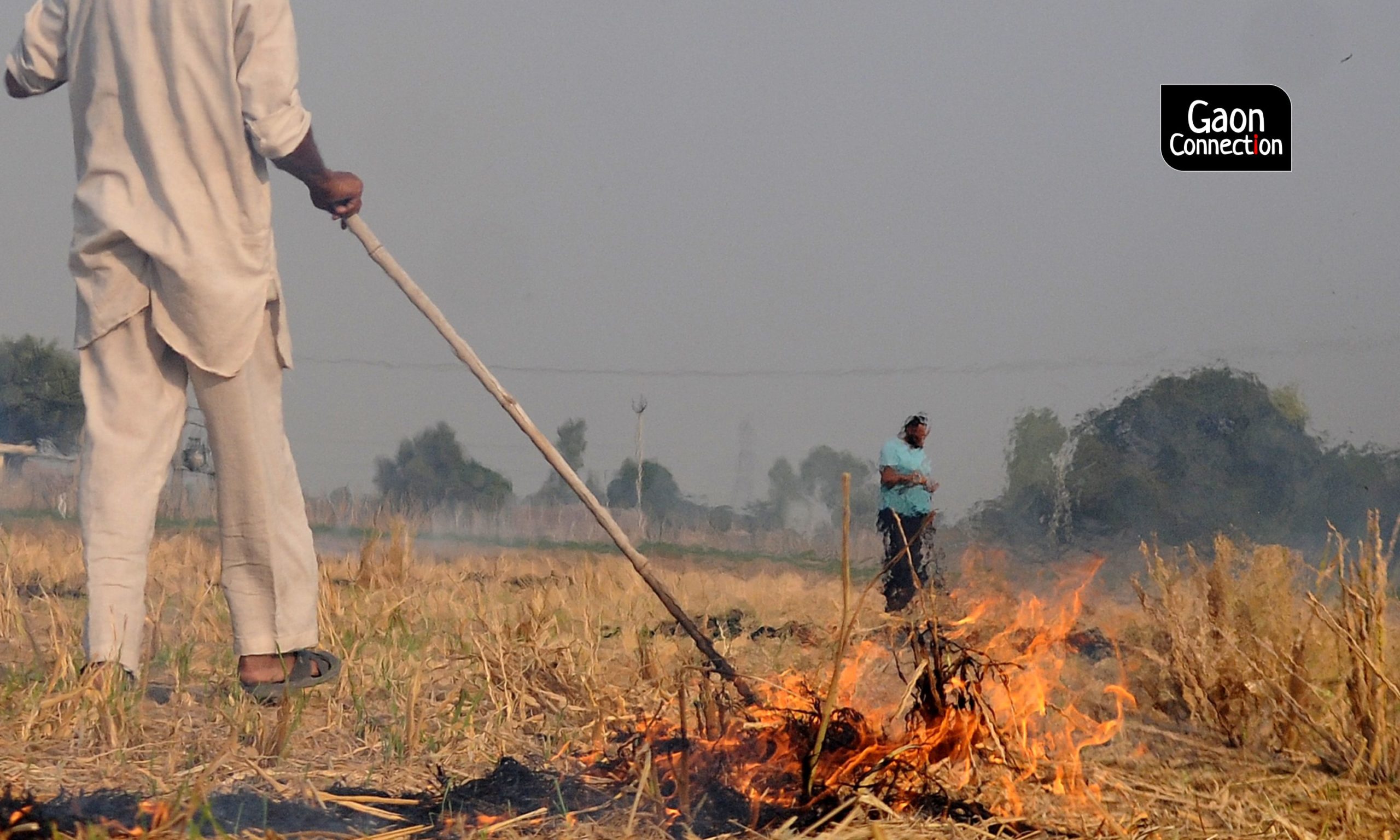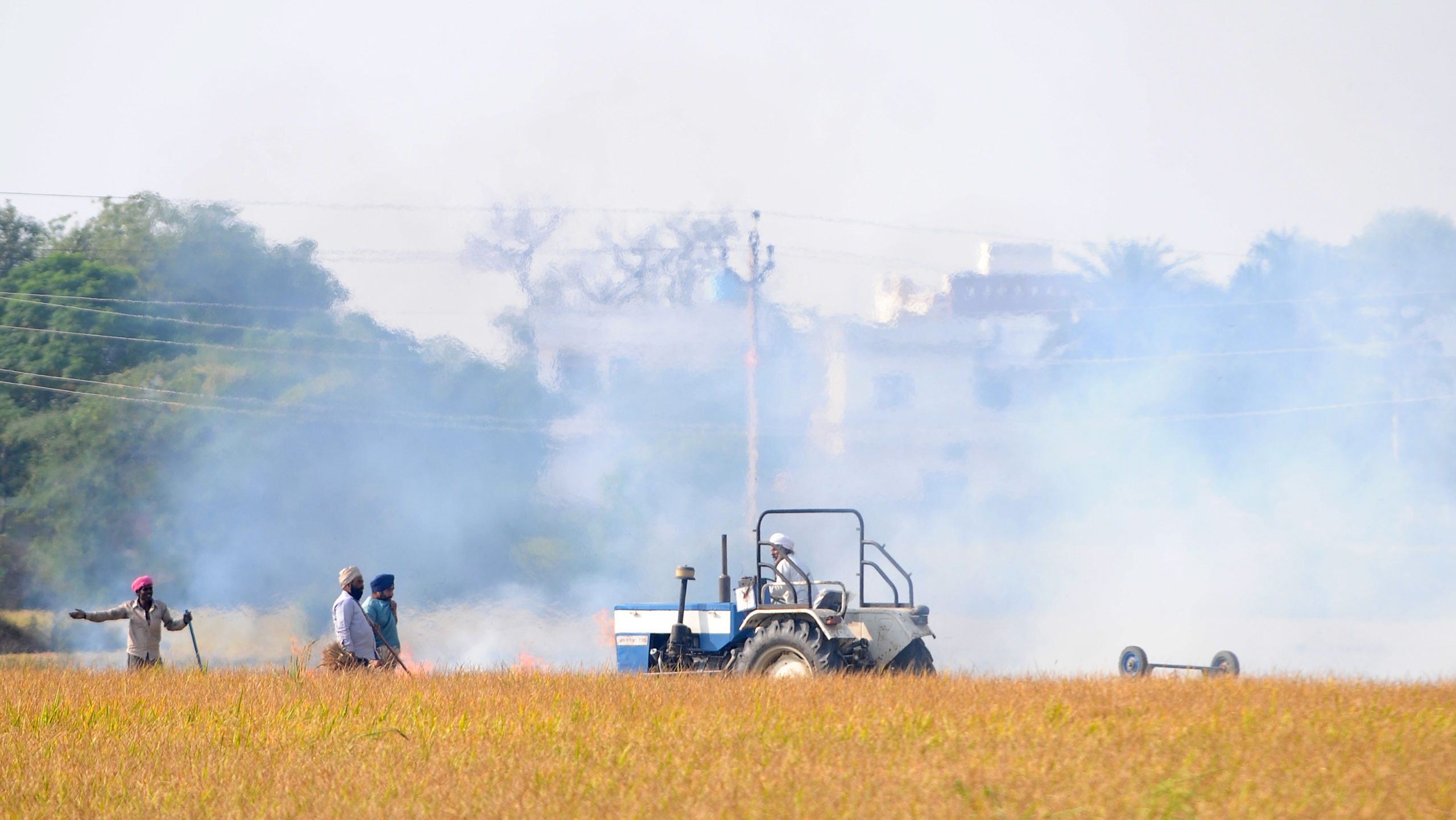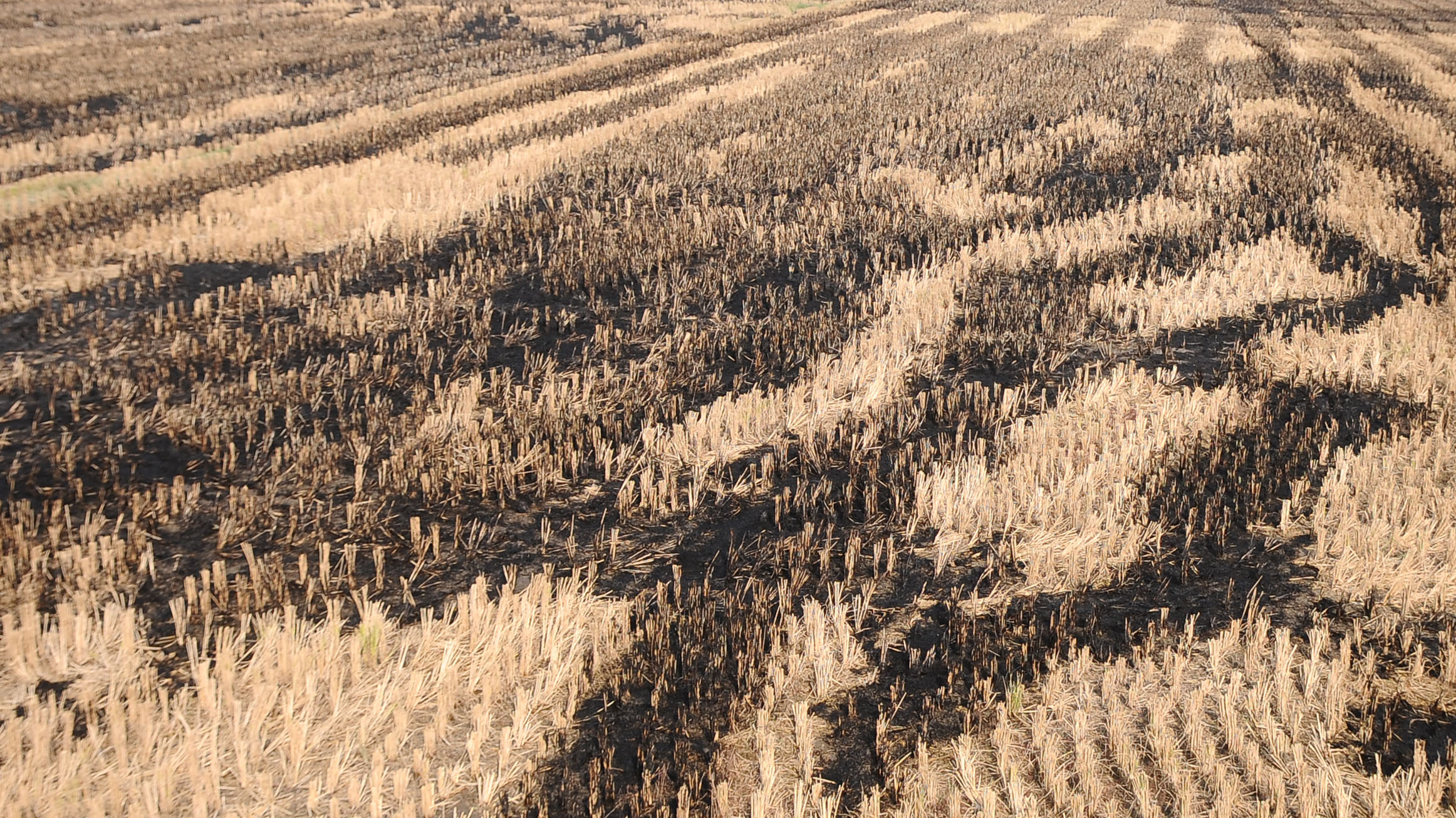Stubble Trouble: Air quality dips in Delhi; spotlight shifts to farmers in Punjab and Haryana
A penalty of Rs 26 lakh has been imposed on over 1,000 farmers for stubble burning in Punjab. The state government claims it has no funds to pay cash incentives to curb stubble burning.


Farmer burning paddy stubble in Noorkhediya village, Patiala district, Punjab. Photo: By arrangement.
It is the onset of winter and air quality has dipped to ‘very poor’ category in the National Capital Region of Delhi (NCR). In the coming two to three months, the situation is expected to worsen. The poor air quality cropped up even in the presidential debate in the United States between presidential candidate Joe Biden and US president Donald Trump who, while speaking on climate change said, “Look at India…it is filthy. Its air is filthy.”
Predictably, the focus of the media and various government authorities has shifted to the farmers of neighbouring states of Punjab and Haryana, who are painted every year as the country’s worst polluters as they burn the stubble in their farmlands to quickly switch over to the next crop season of wheat.
Schemes have been launched, court orders passed, threats issued to imprison the defaulting farmers, several lakh worth of fine collected, but the stubble trouble continues year after year.
Two days back, on October 21, there were 1,379 cases of field fires in Punjab, the highest for this season on a single day. Farmers are setting fire to clear their fields of the crop stubble after their paddy harvest in preparation to sow their next crop.
According to the Punjab Pollution Control Board, there were as many as 9,454 field fires in the last one month between September 21 and October 21 (There were 3,000 fires last year in the same time period). And the situation is likely to worsen. The burning cases were earlier increasing at the rate of 100-120 cases per day. Now it has crossed 1,000 mark daily.
“The fires have shot up this season because of the early harvesting of the paddy,” Rajesh Vasisht, director, department of agriculture and farmers welfare, told Gaon Connection. He said due to labour shortage in wake of COVID-19, the paddy sowing dates were advanced.
“The next 10 days are crucial, but we are dealing with the problem. We have 8,000 nodal officers working on the ground to check it. And a penalty of Rs 26 lakh has already been imposed on over 1,000 farmers for stubble burning across the state,” Krunesh Garg, member secretary, Punjab Pollution Control Board, told Gaon Connection.

Meanwhile, Haryana has reported 2,600 cases of field fires between September 25 and October 18. The per day average cases reported this time was around 140 to 150 till October 16. According to the Haryana State Pollution Control Board, as many as 470 cases of fire have been reported between October 17 and October 18 alone.
“The next one week to ten days is crucial and local administration is working on the ground on awareness drives,” S Narayanan, member secretary, Haryana State Pollution Control Board told Gaon Connection.
The situation in Haryana is not as alarming as in Punjab. “But, we are trying our level best to keep it under control,” assured Narayanan. Last year, over 6,700 stubble fire incidents were reported in the state.
Once the paddy is harvested, the stubble left behind in the fields has to be cleared in order for the next crop to be sown. Burning the stubble is the cheapest and quickest way to do that. Burning the crop stubble needs no labour, and it quickly accomplishes the job of preparing the field to receive the next crop. But the smoke and particles linger in the air causing all that pollution.
The NCR Delhi is already feeling the heat with its air quality index hovering between ‘poor’ and ‘very poor’. The Supreme Court on October 16 appointed retired Justice Madan B. Lokur to submit the status report in the next 15 days. In the meanwhile, the field fires continue to burn in the state.
“If alternatives to stubble burning are not made available, it could result in severe respiratory problems, which will further worsen the COVID-19 situation,” Sanjeev Nagpal, advisor to the Union and the Punjab governments on crop residue management told media.
The smoke and pollution could aggravate matters, agreed, K K Talwar, head of the Punjab government’s expert advisory committee on health. “If pollution level rises due to stubble burning as it has in previous years, it will create adverse conditions for respiratory or lungs related problems and end up aggravating the COVID problem in the affected persons,” he told Gaon Connection.

Where is the compensation money?
But, why is it that farmers continue to burn the stubble in spite of being reprimanded by both the court and the pollution control authorities? In 2019, on November 4, a Supreme Court order directed Punjab and other affected states to provide Rs 2,500 per acre (one acre = 0.4 hectare) to small and marginal farmers so that they do not burn the stubble. A compensation to the tune of Rs 190 million was paid immediately to 29,000 farmers on the orders of the apex court. The compensation is for farmers to either hire manual labour or machinery to clear the stubble.
However, this year, not a single rupee has been paid as compensation to the farmers as the Punjab government is citing lack of funds and hoping for central assistance.
“Burning stubble is our compulsion. It will continue till the time we are adequately compensated,” Gurdeep Singh Rurki, a farmer leader from Ghanour block of Patiala district, told Gaon Connection.
What about subsidised crop residue machines?
Last month, on September 27, Raveen Thukral, media advisor to Punjab chief minister Amarinder Singh, tweeted that the state is giving 23,500 more subsidised crop residue machines to check the stubble burning this year. This is over and above 51,000 agro-machines that the state agriculture department provided to the local farmers in the past two years with a subsidy of Rs 489 crore.
The machines chop, lift and level the left behind stubble after the crop has been harvested and spread the residue evenly on the ground. “A subsidy of Rs 239 crore has already been sanctioned for the twenty three thousand five hundred machines. The government portal is open for the beneficiaries to upload their equipment bills for the necessary subsidy payment and the subsidy is 50 per cent of the total machine cost,” Vasisht said.
In the meanwhile, the demand for subsidies is growing rapidly. “We may be requiring another fifty crore as four thousand more applications have been received over and above their targeted 23,500 subsidy cases,” Vashisht said.
However, many farm unions in the state claim that the subsidies are benefitting only those farmers who have large farm holdings. As per Punjab’s State Farmers’ Policy Report drafted by Punjab State Farmers’ and Farm Workers’ Commission in 2018, there are 26 lakh farmers in the state.

“Only the privileged farmers are using these subsidised machines,” Harinder Lakhowal, general secretary of Bhartiya Kisan Union (BKU) Lakhowal, told Gaon Connection. Besides, a small and marginal farmer (owning up to five acres of land) would never be able to afford them, even with subsidies, he said. The crop residue machine costs anything between Rs 1.5 lakh and Rs 2 lakh, which is out of reach for a small and marginal farmer, even at subsidised rates. Crop residue machines need at least 60-70 HP tractors that can cost almost Rs 10 lakh, said Lakhowal.
The cost of managing paddy residue is close to Rs 3,000 per acre if machinery is hired on rent.
“How do we expect a farmer with two to three acres holding to bear such a heavy cost of farm equipment when residue machinery is used just for seven to ten days a year?” asked Lakhowal.
Farmers are aware that stubble burning causes pollution, but they have no alternative. “Either the state or central government pays us an adequate minimum support price for our produce, or separately pays the cash compensation to manage the stubble. Else, we are forced to burn it,” he said.
According to Charanpal Singh Bagri, a counsel representing farmers in the Supreme Court, while the Punjab government has paid some subsidies for the stubble managing machinery, it has told the Supreme Court that it had no funds to pay cash incentives to farmers to curb stubble burning, in light of the COVID-19 situation. The government has sought the Centre’s help to compensate the farmers, but the Centre contended that it was already sharing the subsidy burden with states for cash residue machines.
“There is no concrete plan to help farmers over the cost of managing the stubble and it is wrong to challan helpless farmers and impose penalty on them for burning the crop residue,” said Bagri.
However, an official in the Punjab agriculture department, on condition of anonymity, said that the state had not initiated any process to identify farmers for the purpose of cash compensation. “This exercise needs at least six months’ time, starting with an undertaking from farmers at the beginning of the sowing season that they will not burn the stubble. Then, we need staff to ensure that they don’t breach their understanding after harvesting. But there was no such exercise,” the official said.
Last year, following Supreme Court’s directions in November, the state government had disbursed a little over Rs 19 crore to 29,343 small and marginal farmers who did not defy the ban on stubble burning. Each beneficiary was paid Rs 2,500 per acre as compensation. But, according to the government, it turned out that about 5,000 farmers submitted wrong or fake claims, following which payment of compensation to farmers was suspended.
“The Punjab Government in February this year constituted a committee under retired justice Metab Singh Gill who convened a meeting with all major farmers unions later that month to discuss the stubble burning issue,” Jagmohan Singh, general secretary of BKU, Dakunda, told Gaon Connection. But while Justice Gill acknowledged the need to give cash subsidies to small and medium farmers to overcome this problem, not a single meeting has been convened since then, Singh said.

Can biogas plants offer a solution?
“The governments, both the centre and the state, are working on a single-track,” R S Ghuman, professor of economics at Centre for Research in Rural and Industrial Development, Chandigarh told Gaon Connection.
It was mechanisation that led to the problem of crop stubble in Punjab, he explained. And now government officers believe that its solution will also emerge from subsidising machines. “They do not realise that the financial condition of the farmers is not as good as it was earlier when they could afford to buy expensive machines,” he pointed out. Ghuman explained how the profit margins in farming have gone down drastically whereas the input cost has gone up considerably. No wonder then, he said, farmers take the cheaper and easier way out by burning stubble, he said.
Ghumman suggested that one way to make good the paddy stubble was to produce biogas. In fact, one bio gas plant is under construction in Sangrur district in which stubble purchased by a private firm from the farmers will be used as raw material to produce not only biogas but other products like bio manure, etc.
“If we have more such plants, I think this problem can be permanently tackled. The farmers will automatically get enough compensation to recover their stubble management cost while the state will have enough biogas production to be used for various other purposes,” said Ghuman.

